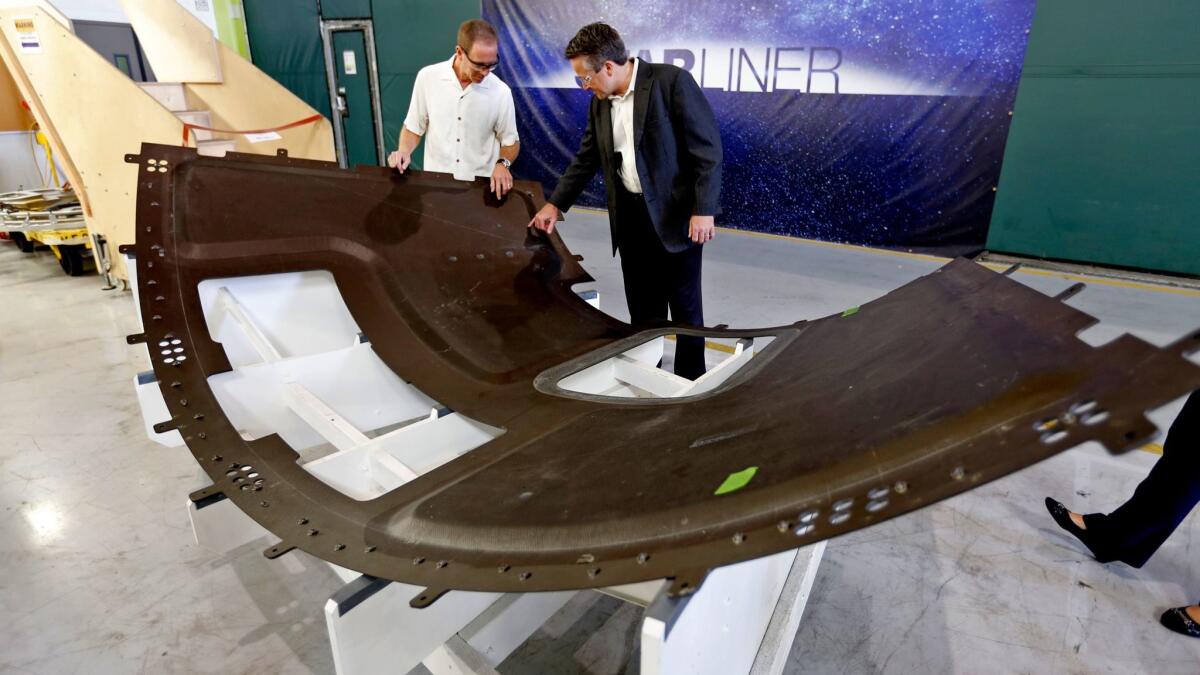SpaceX and Boeing aim to take crews to the space station soon, but Congress has a warning
If all goes according to plan, this year could mark the first time since 2011 that U.S. astronauts will blast off to the International Space Station in an American-made spacecraft.
It’s been a long process to get to this point. Schedule delays have pushed back the first crewed tests of the new astronaut transport capsules being built separately by Boeing Co. and SpaceX under NASA contracts. And the two companies must still complete additional testing and address lingering safety concerns before reaching that milestone.
On Wednesday morning, one message from lawmakers was clear: Safety is paramount.
Rep. Eddie Bernice Johnson (D-Texas), ranking member of the House Committee on Science, Space and Technology, warned company executives and NASA officials during a space subcommittee hearing that they “cannot afford to cut corners” in attempting to prevent a potential gap in U.S. access to the space station.
The U.S. contract with the Russian space agency to take U.S. astronauts to the space station will end in 2019. That’s the same year NASA is set to certify the SpaceX and Boeing vehicles for service — though a U.S. Government Accountability Office official warned that the certification date was “likely to slip” to December 2019 for SpaceX and February 2020 for Boeing.
The U.S. currently pays about $70 million to $80 million per seat for astronauts to ride to the space station on a Russian Soyuz vehicle.
Lawmakers were also resolute about the delays that have pushed the test flights back. The two companies were originally set to certify their capsules for operational missions by 2017.
”The taxpayers and Congress have neither infinite budgets nor infinite patience,” said Rep. Lamar Smith (R-Texas), chairman of the House committee. “Contractors should not assume that the taxpayers and Congress will continue to tolerate this.”
Boeing and SpaceX executives were grilled by congressional leaders Wednesday on safety concerns. They sought more information about the United Launch Alliance Atlas V rocket that will launch Boeing’s CST-100 Starliner capsule, as well as about previous incidents with SpaceX hardware and plans to have astronauts aboard the Crew Dragon capsule while the Falcon 9 rocket is loaded with fuel.
Hans Koenigsmann, vice president of build and flight reliability at SpaceX, said at the hearing that the Hawthorne space company believes this quicker fuel-loading method is safer than traditional methods because loading a denser propellant minimizes exposure time to fueling hazards.
He said the capsule’s launchpad abort system, which would rocket astronauts away from the launch vehicle in case of an emergency, would be engaged during fueling.
William Gerstenmaier, associate administrator at NASA for the human exploration and operations directorate, said the agency was reviewing the process and potential hazards, and would determine the right time to put crew aboard.
The commercial crew program represents a change for NASA. In the past, the agency would award contracts to private companies to build NASA-designed vehicles and spacecraft. With this program, NASA will instead buy a service, rather than the vehicle — much like the contracts it awards to private companies such as Orbital ATK and SpaceX to ferry supplies to the space station.
This could serve as a model for future collaboration, allowing commercial enterprises to gain more experience and expanding into new services that may have once been the purview of government, said David Barnhart, director of the space engineering research center at USC.
“I tend to think it’s the future, in that government elements will procure services that are not necessarily research or far-out innovations,” he said.
Both Boeing’s Starliner capsule — a version of which is undergoing testing at the company’s Huntington Beach facility, with additional tests to come in El Segundo — and SpaceX’s Crew Dragon are set to fly without any crew in August. Boeing’s first crewed test flight is currently scheduled for November, with SpaceX following one month later.
While similar in shape to the capsules of the Apollo moon exploration era, these next-generation spacecraft take advantage of technological advances, such as touchscreens and increased automation. Boeing’s and SpaceX’s contracts with NASA for the vehicles are worth a combined total of up to $6.8 billion.
Both Koenigsmann and John Mulholland, vice president and program manager for Boeing commercial programs, deflected a question about how much each company had invested in their vehicles, saying they did not have that data with them.
The hearing comes just under two weeks after SpaceX launched the classified Zuma satellite, which was reportedly lost.
Northrop Grumman Corp., the satellite’s builder, has said it would not comment on classified missions. When asked about the mission during the hearing, Koenigsmann reiterated SpaceX’s steadfast message that the Falcon 9 rocket “performed very well” and that the company was continuing with its other missions.

Twitter: @smasunaga
More to Read
Inside the business of entertainment
The Wide Shot brings you news, analysis and insights on everything from streaming wars to production — and what it all means for the future.
You may occasionally receive promotional content from the Los Angeles Times.











